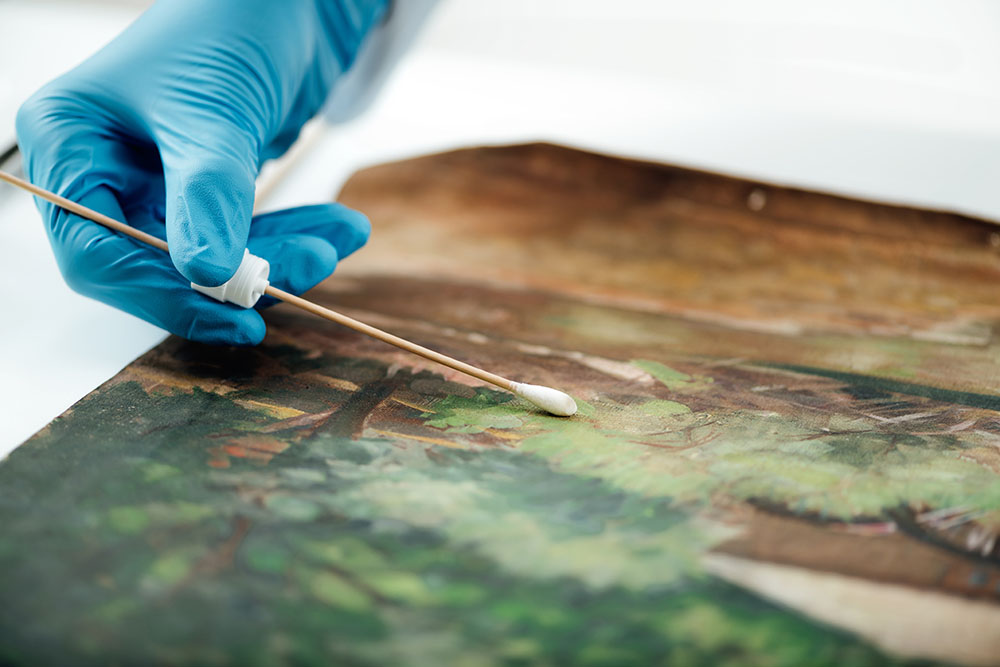How To Prevent Mould From Growing On Paintings

CONTENTS
- Understanding the threat of mould to paintings
- The critical role of humidity control in preventing mould
- Using mould-resistant materials for art preservation
- Regular inspection and maintenance of artwork
- Seeking professional assistance for mould prevention
- Examples of successful mould prevention in artworks
- Future innovations in mould prevention for artworks
- Frequently asked questions
- Get in touch
Finding blotches on a painting can be an alarming discovery. Mould eats away at their longevity and can eventually destroy them if left for too long. However, artwork can be protected with specialist materials and ensure your work remains untouched by mould.
At ICE Cleaning, we offer high-quality mould cleaning services. Our technicians are prepared to tackle any challenging mould issue, identifying the root cause and preventing its return. We utilise modern technology to ensure the best results, satisfying our clients.
Read on to learn about why mould grows on paintings and how to prevent it.
Understanding the threat of mould to paintings
Mould is a type of fungus that thrives in damp environments and poses a threat to paintings. Its spores can latch onto surfaces and start growing when conditions are favourable.
The damage mould inflicts on artworks is not merely superficial; it goes beyond damaging their aesthetic appeal. Over time, these microorganisms can degrade paint layers and even penetrate into the canvas or wood beneath.
This leads not only to visual disfigurement but also structural damage in artworks. The severity escalates if left unchecked as some types of mould produce mycotoxins, which are hazardous to humans.
Prevention is critical to protect your artwork or a historical piece from degradation. This involves understanding how mould operates, its conducive environment, potential impact on artwork materials and effective countermeasures.
The critical role of humidity control in preventing mould
Humidity control plays a vital role in preventing mould growth in paintings. Excessive moisture can act like a catalyst for mould spores, letting them thrive and cause damage. To prevent this, an optimal humidity level between 40% and 60% is integral.
Maintaining these levels can be challenging, especially during wet seasons or in damp environments. Utilising tools such as dehumidifiers and hygrometers can aid in effectively monitoring and controlling the humidity inside.
Taking steps to manage your environment’s humidity both preserves artwork and makes spaces healthier for inhabitants. It can also prevent the spread to parts of your home, like the walls and ceiling.
Using mould-resistant materials for art preservation
Mould-resistant materials are crucial in art preservation. They act as a protective barrier, stopping mould spores from latching onto and damaging precious artworks.
One popular choice is acrylic paint, which is known to resist moisture absorption. Unlike traditional oil paints that can hold dampness, acrylic polymers offer improved protection against humidity-induced mould growth.
Besides painting mediums, consider the use of mould-resistant framing materials. These could include treated woods or metal frames that deny any foothold for fungal development.
To ensure your artwork is kept safe in the future, you should seek professional help when choosing these materials. Mould remediation experts have vast experience identifying and using the most effective mould-preventive resources available.
Regular inspection and maintenance of artwork
The upkeep of paintings involves more than just dusting. Regular inspections can help spot early signs of mould, which could save the artwork from irreversible damage.
When checking a painting, look for discolouration or fuzzy patches, because this indicates mould growth. Moreover, be vigilant about changes in texture or smell.
Besides visual checks, it is also crucial to maintain optimal conditions around your artwork to prevent mould formation. This includes managing humidity levels and ensuring proper ventilation.
Experts suggest that you must never wrap a wet painting in plastic and it must dry before being displayed and inspected. If it has been glazed, the frame must be removed to prevent damage.
Sunlight is integral to preventing mould on paintings, and a steady temperature between 18-20°C and a 45% humidity level. You must also ensure the paintings are kept in a dry area, and remove them if a room is affected by water damage.
Seeking professional assistance for mould prevention
There are instances when professional help becomes necessary if mould has spread from paintings to your property's structure. Experts have in-depth knowledge and experience that lets them identify risks before they escalate.
These professionals use advanced tools to detect humidity levels and possible fungal growth spots, ensuring optimal conditions for your property's longevity.
Their extensive training allows them to suggest the most effective preventative measures tailored specifically for domestic and commercial dwellings.
Hiring a specialist cleaning service helps maintain your property value and also extends its lifespan significantly by keeping damaging mould at bay.
Examples of successful mould prevention in artworks
The battle against mould on paintings is an ongoing challenge. However, preventative measures continue to improve and be implemented in art galleries worldwide.
For example, the Tate Gallery team works tirelessly to prevent mould from growing on many acrylic art pieces they store and display.
The experts regularly adjust the humidity and temperature conditions around the artwork to prevent growth. They discuss this process in their case study about acrylic paint.
Many private collectors or sellers who work with artworks will regularly use varnishes with anti-mould properties.
This proactive measure effectively prevented any signs of mould infestation over many years. Overall, timely interventions and preventive measures can indeed help protect artworks from destructive mould spores.
Future innovations in mould prevention for artworks
The field of artwork preservation is full of innovative solutions. The fight against mould on paintings is no different, and advancements are emerging to give us more effective methods.
A promising innovation lies in nanotechnology. As the field of art conservation continues to expand, it utilises nanotechnology to remove grime and dirt from paintings. It is also used to remove flaky paints and restore the colour to its original composition.
Specialist agents, another potential, use harmless bacteria or fungi to combat harmful ones. This eco-friendly approach is used to remove mould from paintings as it is a gentle alternative to strong chemicals used for industrial means.
Innovative tools such as advanced humidity control systems that adapt based on environmental conditions also offer hope. These high-tech systems will help maintain optimal conditions for preserving artworks on public display.
Frequently asked questions
How do you get rid of mould on paintings?
Do not try to clean it yourself, instead consult a professional conservator.
Can pictures with mould be saved?
Yes, but it's tricky. It often needs gentle cleaning and sometimes even restoration by pros skilled in dealing with mould damage.
What to do when canvas has mould on it?
If your canvas is infested, isolate it first. Clean gently using a soft brush and mild detergent solution before drying thoroughly.
How do you prevent mould on paintings?
To avoid this problem, control humidity levels at home and inspect artworks regularly for early signs of growth. Also consider using anti-mould materials if necessary.
Get in touch
Our technicians at ICE Cleaning are experts with years of training and experience in mould remediation. We offer our services nationwide and will work tirelessly to meet our client's needs. We can help you find the root cause of a mould infestation and prevent its return in the future.
You can speak to our friendly customer service team today for a free, no-obligation quote and survey by contacting us at 0208 066 0360 and enquiries@icecleaning.co.uk. We can be on-site within a matter of hours in an emergency and will respond to your call 24/7, 365 days a year.

Speak with me today,
I’m here to help
By asking you a few questions either via phone or email I can immediately provide a realistic estimation of the cost.
You’re in good company. We’ve cleaned for the following commercial clients… View all

Why choose us?
- Cater to a wide variety of cleaning situations
- Nationwide coverage, available 24/7
- Cater to commercial and domestic clients
- Free survey provided prior to quotation
- Emergency response team
- Offer a bespoke service designed to suit all your needs
- All technicians hold professional health and safety qualifications, including BICSc, IOSH, Dewpoint Professional & Safe Contractor
We’re fully accredited
We place best practise, professional expertise and health and safety at the core of our business. We’re fully compliant with all legal obligations. You can view a list of our accreditations below, or visit our Health & Safety page for more information.











-RGB-small.1707319151.jpg)




















